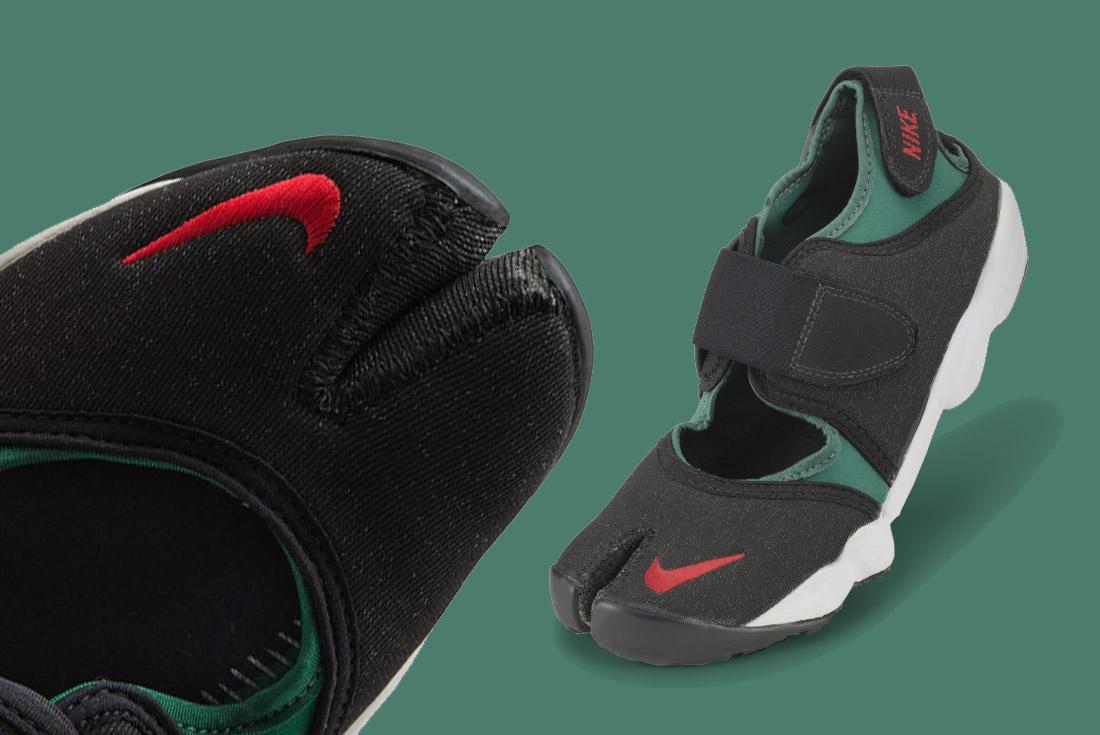Wonderfully Weird: Appreciating the Nike Air Rift
Despite having been around for 25 years now, the remains one of the wackiest, weirdest, yet most wonderful sneakers of all time. Its idiosyncratic split-toed design and shoe-slash-sandal build are some of its more controversial features, and won’t stop catching stares any time soon.
Among all the excitement and commotion created by its bubble-bottomed brethren, the Rift has long had a cult following enhanced by left-field colourways, collaborations, and even matching socks! But beneath its hooved surface, the Rift’s design has been incredibly prescient in informing some of the sneaker industry’s most cutting-edge designs to this day. Happy 25th birthday!
An Abridged History
The Air Rift’s origin story has been well-documented over the years, so here’s the crib notes version. It was originally released in 1995, and its name references the Great Rift Valley that runs through Kenya. Of course, its OG black, green and red colourway was a clear nod to the Kenyan flag.
For the sake of nerdery, the Air Rift was rendered in black and purple during its sampling stages, colours similar to the OG ‘Purple Punch’ , and its outsole was modified a number of times too. The madcap designer behind the Air Rift was Kip Buck, a keen ultra-distance runner and model maker at the Swoosh, who wanted to replicate the feeling of running barefoot. Like so many , it's said also played a small part in this unique sneaker’s inception.
Tabi Toes and the Genealogy of Speed
That split-toe is undoubtedly the Air Rift’s signature design feature. However, Nike were far from the first to feature this decoupled toe structure. made a splash from day dot with his tabi footwear in 1989 – iconic designs which live on over . However, the split-toed origins actually date back to as early as 15th century Japan, where split-toe tabi socks were used in tandem with the rigid straps on geta sandals. By the mid-20th century, the industrialisation of rubber production bonded outsoles to tabi uppers, forming Jika-tabi, which were used primarily as functional, agile workwear.
Similarly, the Air Rift’s design was born out of a never-ending quest for runners to experience unrestricted motion. The sandal-like midfoot and heel Velcro straps allowed for immensely soft, stretchy uppers that hugged the foot with ease. It was innovations like these, and other experiments like the , Air Huarache, and , that led to the creation of the game-changing Nike Free, later immortalised in the .
Turning Japanese, and Anarchy in the UK
It seems Japan had an almost spiritual kinship with tabi, and the Air Rift become a as the world entered the 21st century. The fashionable youth of Tokyo and beyond pictured in the seminal street style magazine were more often than not pictured wearing the Air Rift. Plus, the fact that OG pairs were shipped with special Nike tabi socks may have helped this. Even with its sporting origins, it was quickly adopted as an easy-wearing and comfortable street shoe.
Across the pond, the Air Rift also took off in Europe and the UK, where websites devoted to the silhouette cropped up. Forums like fuk.co.uk (Fashion UK) and were depositories of information, filled with Web 1.0 artefacts and preserved since time immemorial. Even the had devout Rift followers!
Halle Berry
Between the years 2002 and 2004, Nike’s Artist Series tapped creative types like artists, musicians and actors to collaborate on limited-edition sneakers. It included entries like the Stash x Air Classic BW and Eminem x Air Max Burst, which remain some of the rarest Nikes ever. However, it’s not as widely known that alongside the N.E.R.D. x Dunk and ESPO x Air Force 2 Low, there was a Halle Berry x Air Rift! This trio formed the third instalment of the Artist Series.
The Halle Berry Rifts were more likely to be found walking down Hollywood Boulevard than pounding the sandy savannah in Kenya – but by then, it was the early 2000s, and the Rift was definitely a casual shoe. However, there was something rather prescient about the Shale/Ceramic/Dark Blue/Grey colourway that would return in similar forms during the late-2010s trail revival.
And, as the dawn of the early 2000s brought on a renaissance period of sneaker culture, Nike laid the foundations with highly collectible colourways and limited editions that sneakerheads and adventurous normies snapped up, like the ‘Brazil’ Bs from 2000 and the glittery Milkfed collaboration from 2008. There were also some crazy variants, like strapless slip-ons and mid-cut pony hair versions!
Modern Revival and the ISPA Connection
In spite of its underrated status, something at Nike’s been making sure the Air Rift returns every now and again. It’s made noise throughout the 2010s with both retro reissues and material variants. Its distinct design has proven antecedent to contemporary Swoosh silhouettes, like 2015’s NikeLab Free Rift Sandal, 2016’s , and 2019’s .
Now, the Air Rift’s spirit lives on. Nike recently released the very Mad Max and ISPA Drifter. Both are absolutely chaotic sneakers in all the right ways – what’s that there? A decoupled toe, whose design DNA goes back 25 years.
With all this said and done, where’s the 2020 retro of the OG ‘Kenya’ and ‘Concord’ Air Rifts?
Check out even more detailed product deep dives in the Features section .
